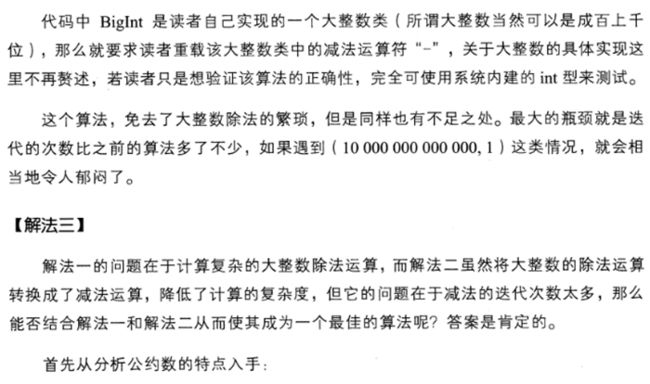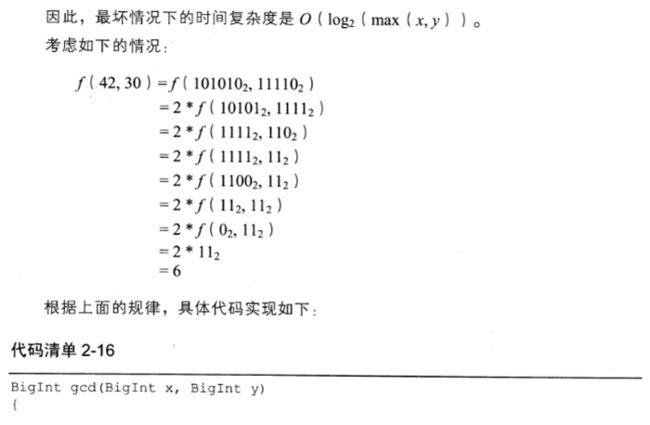最大公约数问题
以上内容摘自《编程之美》P150-154。
为了方便使用,下面是可拷贝的代码:
Math.h
#pragma once class Math { public: Math(void); ~Math(void); public : //编程之美P150-154 //求最大公约数,欧几里德——辗转相除法 static int Gcd1(int x, int y); //求最大公约数,欧几里德——辗转相除法(变相将除法变成了减法) static int Gcd2(int x, int y); static int Gcd3(int x, int y); inline static bool IsEven(int x); inline static int Absolute(int x); };
Math.cpp
#include "Math.h" Math::Math(void) { } Math::~Math(void) { } int Math::Gcd1(int x, int y) { //y, x%y顺序不能错; return y ? Gcd1(y, x % y) : x; } int Math::Gcd2(int x, int y) { //与Gcd1相同的方式,但由于x%y计算速度较x-y要慢,但效果相同,所以换用x - y // 但用减法和除法不同的是,比如和,%20=10,-20=70,也就是-4×=10 // 也就是说迭代次数较Gcd1而言通常是增加了。 return y ? Gcd1(y, x - y) : x; } int Math::Gcd3(int x, int y) { if(x < y) return Gcd3(y, x); if(y == 0) return x; else { if(IsEven(x)) { if(IsEven(y)) return (Gcd3(x >> 1, y >> 1) << 1); else return Gcd3(x >> 1, y); } else { if(IsEven(y)) return Gcd3(x, y >> 1); else return Gcd3(y, x - y); } } } bool Math::IsEven(int x) { return !(bool)x & 0x0001; } int Math::Absolute(int x) { return x < 0 ? -x : x; }
Main.cpp
#include <stdafx.h> #include <iostream> #include "Math.h" using namespace std; int _tmain(const int & arg) { cout<<"Math::Gcd1(42,30) = "<<Math::Gcd1(42,30)<<endl; cout<<"Math::Gcd1(30,42) = "<<Math::Gcd1(30,42)<<endl; cout<<"Math::Gcd1(50,50) = "<<Math::Gcd1(50,50)<<endl; cout<<"Math::Gcd1(0,0) = "<<Math::Gcd1(0,0)<<endl; cout<<"Math::Gcd1(-42,-30) = "<<Math::Gcd1(-42,-30)<<endl; cout<<"Math::Gcd1(-42,30) = "<<Math::Gcd1(-42,30)<<endl; cout<<"------------------------------"<<endl; cout<<"Math::Gcd2(42,30) = "<<Math::Gcd2(42,30)<<endl; cout<<"Math::Gcd2(30,42) = "<<Math::Gcd2(30,42)<<endl; cout<<"Math::Gcd2(50,50) = "<<Math::Gcd2(50,50)<<endl; cout<<"Math::Gcd2(0,0) = "<<Math::Gcd2(0,0)<<endl; cout<<"Math::Gcd2(-42,-30) = "<<Math::Gcd2(-42,-30)<<endl; cout<<"Math::Gcd2(-42,30) = "<<Math::Gcd2(-42,30)<<endl; cout<<"------------------------------"<<endl; cout<<"Math::Gcd3(42,30) = "<<Math::Gcd3(42,30)<<endl; cout<<"Math::Gcd3(30,42) = "<<Math::Gcd3(30,42)<<endl; cout<<"Math::Gcd3(50,50) = "<<Math::Gcd3(50,50)<<endl; cout<<"Math::Gcd3(0,0) = "<<Math::Gcd3(0,0)<<endl; cout<<"Math::Gcd3(-42,-30) = "<<Math::Gcd3(-42,-30)<<endl; cout<<"Math::Gcd3(-42,30) = "<<Math::Gcd3(-42,30)<<endl; return 0; }
不过有一点值得一提,就是所谓性能最好效率最高的Gcd3不支持负数,也就是最后两行测试代码无法通过。但是限于对负数的最大公约数并没有定义,也就是说即便上面的Gcd1和Gcd2好像算出了负数,但它们的结果没有意义。








